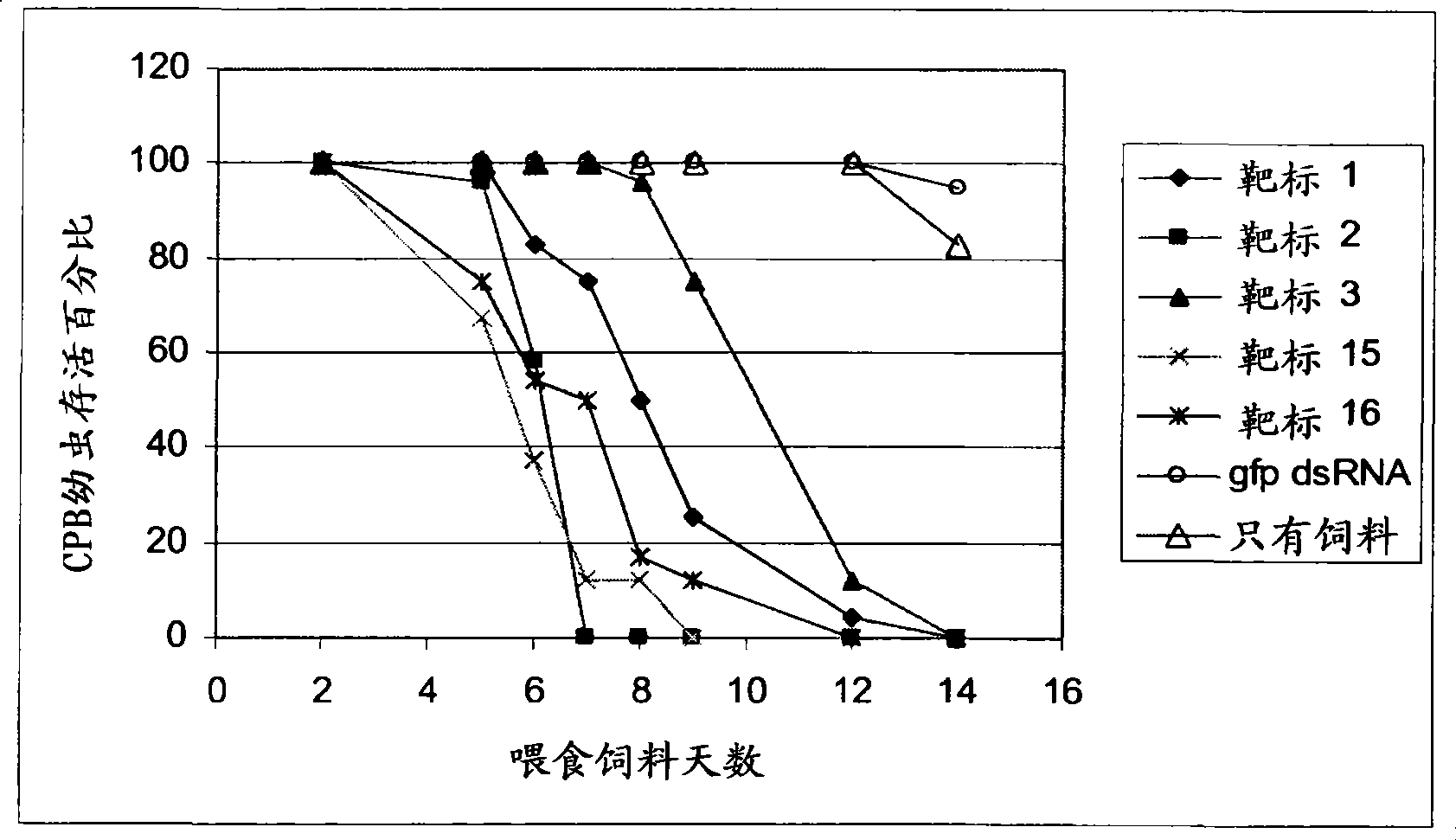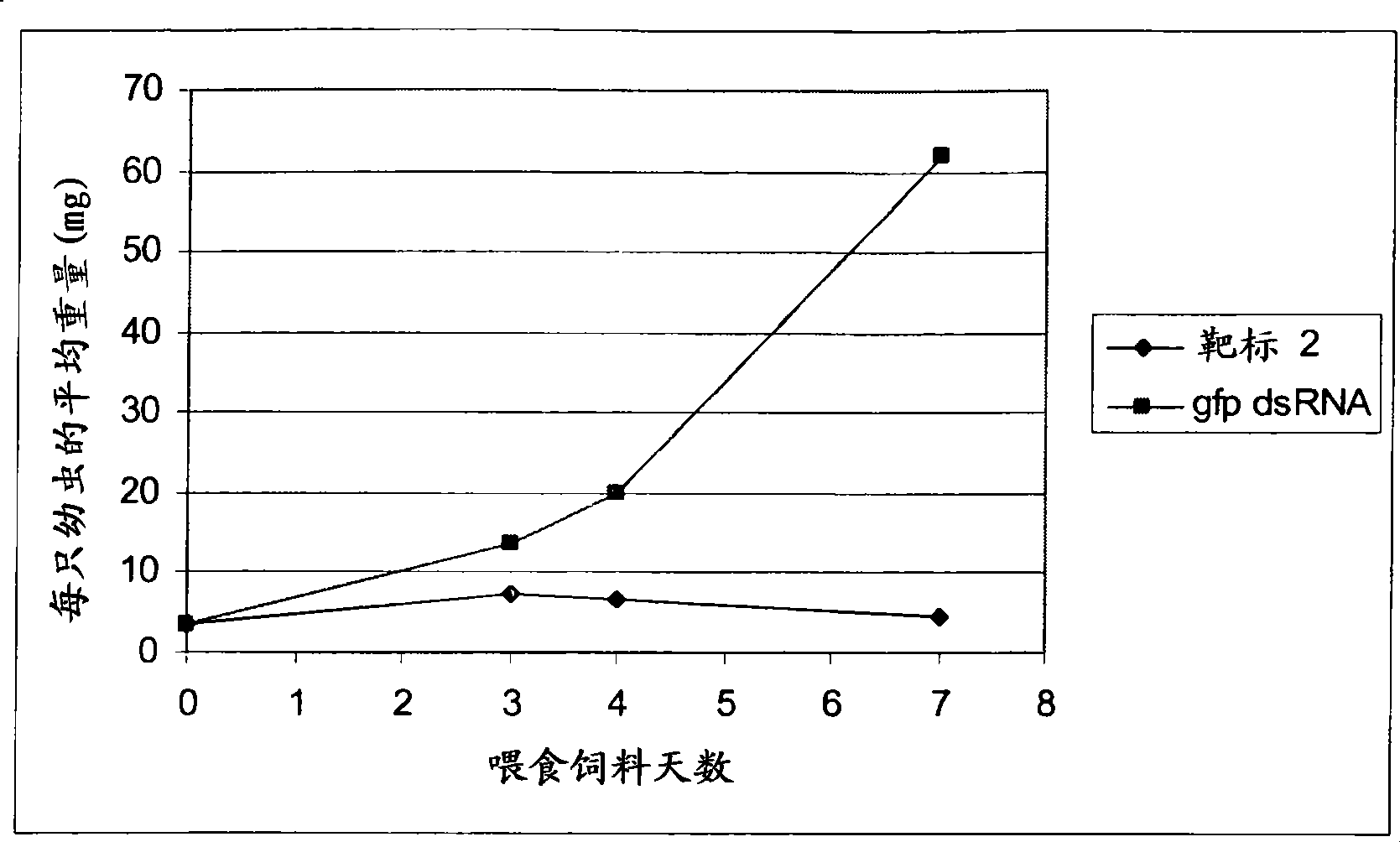DsRNA as insect control agent
A technology for insects and insecticides, applied in the control of insects, genetic constructs of dsRNA, preventing insects from invading the field, and can solve problems such as unknown gene expression
- Summary
- Abstract
- Description
- Claims
- Application Information
AI Technical Summary
Problems solved by technology
Method used
Image
Examples
Embodiment 1
[0264] Example 1: Silencing of Target Genes in C. elegans in High Throughput Screening
[0265] A C. elegans genome-wide library was made between the same two T7 promoters and terminators in the pGN9A vector (WO 01 / 88121), which in the presence of T7 polymerase expression induced by IPTG sense and reverse expression of direction.
[0266] This library was transformed into the AB301-105(DE3) bacterial strain in a 96-well plate format. For genome-wide screening, these bacterial cells were fed a nuclease-deficient C. elegans nuc-1 (e1392) strain.
[0267] C. elegans nuc-1(e1392) was fed in 96-well plates with dsRNA produced in the AB301-105(DE3) bacterial strain as follows: Nuc-1 eggs were transferred to separate plates and The L1 generation was synchronized by incubating them simultaneously at 20°C. Add 100 μL of liquid growth medium containing IPTG and OD containing the C. elegans dsRNA library. 600 10 μL of AB301-105 (DE3) bacterial cell culture was added to a 96-well plat...
Embodiment 2
[0281] Example 2: Identification of orthologs of Drosophila melanogaster
[0282] As described in Example 1, a number of C. elegans lethal sequences were identified and can be used to identify orthologues in other species. For example, the C. elegans lethal sequence can be used to identify orthologous sequences in Drosophila melanogaster. That is, each C. elegans sequence can be used to search public databases such as GenBank for D. melanogaster orthologs. Select possible Drosophila melanogaster orthologs with a high degree of sequence homology (E value preferably less than or equal to 1E-30) that are the best hits from a mutual blast, the latter referring to those from different organisms ( For example, the sequences of Caenorhabditis elegans and Drosophila melanogaster) are mutually the best blast hit results. For example, sequence C from C. elegans was aligned to sequence D from Drosophila melanogaster using BLAST. If D. melanogaster sequence D is the best hit for sequ...
Embodiment 3
[0283] Embodiment 3: Potato beetle (Colorado potato beetle, CPB)
[0284] A. Cloning the partial gene sequence from the potato leaf beetle
[0285] Potato leaf beetle (Colorado beetle; source: Jeroen van Schaik, Entocare CV Biologische Gewasbescherming, Postbus 162, 6700 AD Wageningen, the Netherlands) isolate high quality intact RNA. Genomic DNA was removed from this RNA preparation by DNase (Cat. Nr. 1700, Promega) treatment following the manufacturer's instructions. According to the manufacturer's instructions, using a commercially available kit (SuperScript TM III Reverse Transcriptase, Cat. Nr. 18080044, Invitrogen, Rockville, Maryland, USA) to obtain cDNA.
[0286] To isolate cDNA sequences comprising part of the LD001, LD002, LD003, LD006, LD007, LD010, LD011, LD014, LD015, LD016, LC018, and LD027 genes, Amplitaq Gold (Cat. Nr. N8080240, Applied Biosystems) for a series of PCR reactions.
[0287] The degenerate primer sequences used to amplify each gene are give...
PUM
| Property | Measurement | Unit |
|---|---|---|
| absorbance | aaaaa | aaaaa |
| absorbance | aaaaa | aaaaa |
Abstract
Description
Claims
Application Information
 Login to View More
Login to View More - R&D
- Intellectual Property
- Life Sciences
- Materials
- Tech Scout
- Unparalleled Data Quality
- Higher Quality Content
- 60% Fewer Hallucinations
Browse by: Latest US Patents, China's latest patents, Technical Efficacy Thesaurus, Application Domain, Technology Topic, Popular Technical Reports.
© 2025 PatSnap. All rights reserved.Legal|Privacy policy|Modern Slavery Act Transparency Statement|Sitemap|About US| Contact US: help@patsnap.com



